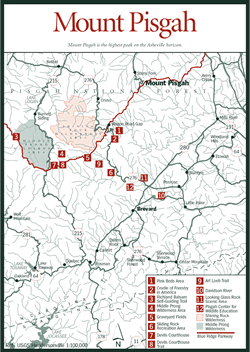 Mount
Pisgah
Mount
Pisgah  Mount
Pisgah
Mount
Pisgah [Fig. 26] In 1776, General Griffith Rutherford led an expedition into Western North Carolina against the Cherokee Indians. A Scots-Irish Presbyterian minister named Reverend James Hall accompanied the band, and, according to local folk history, Hall was awestruck by the view of the French Broad River Valley as seen from the area's highest peak. Reminded of the biblical Mount Pisgah from which Moses viewed the Promised Land after his 40-year odyssey through the desert wilderness, Hall gave the North Carolina mountain peak its present name. Pisgah was subsequently applied to the surrounding forest lands.
Perched below Mount Pisgah's 5,721-foot outline and overlooking the Pink Beds area, George Vanderbilt constructed a large hunting lodge, the Buck Spring Lodge, for his family and guests. To reach the lodge, he commissioned a trail to connect with the Biltmore Estate at the present-day site of Bent Creek Recreation Area [Fig. 25(2)]. The trail became known as the Shut-In Trail due to the dense rhododendron (Rhododendron catawbiense and R. maximum) foliage through which it passed. It remains today as a popular recreation trail that parallels the Blue Ridge Parkway for more than 16 miles.
From the Mount Pisgah parking area, the 1.6-mile Mount Pisgah Trail rises 712 feet through a northern red oak forest before giving way to a heath bald at the peak. It earns a moderate to strenuous rating because the last half of the climb grows particularly steep and rocky, but spectacular views of the Shining Rock Wilderness [Fig. 26] to the west-southwest and the French Broad River Valley to the north and east make the climb well worth the effort.
Also accessible from the southern end of the parking area, the Buck Spring Trail leads through a mixed forest of hemlock and oak past the site of the Buck Spring Lodge. Hikers can create a number of shorter hikes with the help of the map boards in both the Pisgah Inn and campground parking lots.
This area is rich with varying elevations and habitats enhanced by easy access to good viewing sites. The parking lot at the nearby Pisgah Inn, for example, serves as a good spot for watching the American woodcock (Philohela minor) perform its courtship displays at dusk even for those who cannot travel long treks. Other late-spring and summer birds include the downy woodpecker (Dendrocopos pubsecens), white-breasted nuthatch (Sitta carolinensis), ruby-throated hummingbird (Archilochus colubris), cedar waxwing (Bombycilla cedrorum), and several species of warblers. The campground across from the Pisgah Inn is also an ideal spot for observing birds accustomed to high elevations such as the brown creeper (Certhia familiaris), veery (Hylocichla fuscenscens), rose-breasted grosbeak (Pheucticus ludovicianus), and Canada warbler (Wilsonia canadensis). Visitors to the parking lot of the Pisgah picnic grounds report seeing scarlet tanager (Piranga olivacea), red crossbills (Loxia curvirostra), and common ravens (Corvus corax).